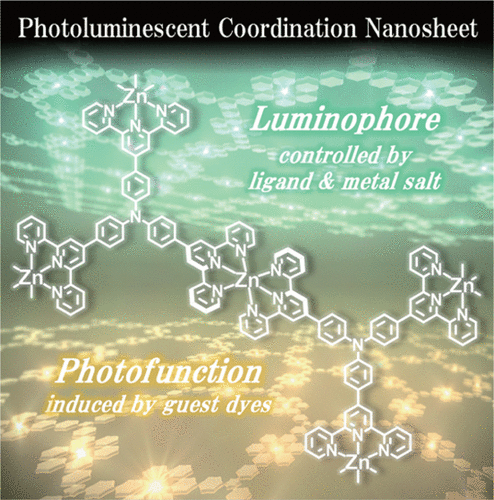当前位置:
X-MOL 学术
›
J. Am. Chem. Soc.
›
论文详情
Our official English website, www.x-mol.net, welcomes your
feedback! (Note: you will need to create a separate account there.)
Coordination Nanosheets Based on Terpyridine–Zinc(II) Complexes: As Photoactive Host Materials
Journal of the American Chemical Society ( IF 14.4 ) Pub Date : 2017-04-04 , DOI: 10.1021/jacs.6b12810 Takamasa Tsukamoto 1, 2 , Kenji Takada 1 , Ryota Sakamoto 1, 3 , Ryota Matsuoka 1 , Ryojun Toyoda 1 , Hiroaki Maeda 1 , Toshiki Yagi 1 , Michihiro Nishikawa 4 , Naoaki Shinjo 1 , Shuntaro Amano 1 , Tadashi Iokawa 1 , Narutaka Ishibashi 1 , Tsugumi Oi 1 , Koshiro Kanayama 1 , Rina Kinugawa 1 , Yoichiro Koda 1 , Toshiyuki Komura 1 , Shuhei Nakajima 1 , Ryota Fukuyama 1 , Nobuyuki Fuse 1 , Makoto Mizui 1 , Masashi Miyasaki 1 , Yutaro Yamashita 1 , Kuni Yamada 1 , Wenxuan Zhang 1 , Ruocheng Han 1 , Wenyu Liu 1 , Taro Tsubomura 4 , Hiroshi Nishihara 1
Journal of the American Chemical Society ( IF 14.4 ) Pub Date : 2017-04-04 , DOI: 10.1021/jacs.6b12810 Takamasa Tsukamoto 1, 2 , Kenji Takada 1 , Ryota Sakamoto 1, 3 , Ryota Matsuoka 1 , Ryojun Toyoda 1 , Hiroaki Maeda 1 , Toshiki Yagi 1 , Michihiro Nishikawa 4 , Naoaki Shinjo 1 , Shuntaro Amano 1 , Tadashi Iokawa 1 , Narutaka Ishibashi 1 , Tsugumi Oi 1 , Koshiro Kanayama 1 , Rina Kinugawa 1 , Yoichiro Koda 1 , Toshiyuki Komura 1 , Shuhei Nakajima 1 , Ryota Fukuyama 1 , Nobuyuki Fuse 1 , Makoto Mizui 1 , Masashi Miyasaki 1 , Yutaro Yamashita 1 , Kuni Yamada 1 , Wenxuan Zhang 1 , Ruocheng Han 1 , Wenyu Liu 1 , Taro Tsubomura 4 , Hiroshi Nishihara 1
Affiliation

|
Photoluminescent coordination nanosheets (CONASHs) comprising three-way terpyridine (tpy) ligands and zinc(II) ions are created by allowing the two constitutive components to react with each other at a liquid/liquid interface. Taking advantage of bottom-up CONASHs, or flexibility in organic ligand design and coordination modes, we demonstrate the diversity of the tpy-zinc(II) CONASH in structures and photofunctions. A combination of 1,3,5-tris[4-(4'-2,2':6',2″-terpyridyl)phenyl]benzene (1) and Zn(BF4)2 affords a cationic CONASH featuring the bis(tpy)Zn complex motif (1-Zn), while substitution of the zinc source with ZnSO4 realizes a charge-neutral CONASH with the [Zn2(μ-O2SO2)2(tpy)2] motif [1-Zn2(SO4)2]. The difference stems from the use of noncoordinating (BF4-) or coordinating and bridging (SO42-) anions. The change in the coordination mode alters the luminescence (480 nm blue in 1-Zn; 552 nm yellow in 1-Zn2(SO4)2). The photophysical property also differs in that 1-Zn2(SO4)2 shows solvatoluminochromism, whereas 1-Zn does not. Photoluminescence is also modulated by the tpy ligand structure. 2-Zn contains triarylamine-centered terpyridine ligand 2 and features the bis(tpy)Zn motif; its emission is substantially red-shifted (590 nm orange) compared with that of 1-Zn. CONASHs 1-Zn and 2-Zn possess cationic nanosheet frameworks with counteranions (BF4-), and thereby feature anion exchange capacities. Indeed, anionic xanthene dyes were taken up by these nanosheets, which undergo quasi-quantitative exciton migration from the host CONASH. This series of studies shows tpy-zinc(II) CONASHs as promising potential photofunctional nanomaterials.
中文翻译:

基于三联吡啶-锌(II)配合物的配位纳米片:作为光活性主体材料
包含三元三联吡啶 (tpy) 配体和锌 (II) 离子的光致发光配位纳米片 (CONASH) 是通过允许两种组成成分在液/液界面相互反应而产生的。利用自下而上的 CONASH,或有机配体设计和配位模式的灵活性,我们展示了 tpy-zinc(II) CONASH 在结构和光功能方面的多样性。1,3,5-三[4-(4'-2,2':6',2"-三联吡啶基)苯基]苯 (1) 和 Zn(BF4)2 的组合提供了一种阳离子 CONASH,其特征是双 ( tpy)Zn 复合基序 (1-Zn),而用 ZnSO4 取代锌源实现了具有 [Zn2(μ-O2SO2)2(tpy)2] 基序 [1-Zn2(SO4)2] 的电荷中性 CONASH . 差异源于使用非配位 (BF4-) 或配位和桥连 (SO42-) 阴离子。配位模式的变化改变了发光(1-Zn 中为 480 nm 蓝色;1-Zn2(SO4)2 中为 552 nm 黄色)。光物理性质的不同还在于 1-Zn2(SO4)2 显示出溶剂发光变色,而 1-Zn 则没有。光致发光也受 tpy 配体结构的调节。2-Zn 包含以三芳胺为中心的三联吡啶配体 2 并具有双 (tpy) Zn 基序;与 1-Zn 相比,它的发射显着红移(590 nm 橙色)。CONASHs 1-Zn 和 2-Zn 具有带有抗衡阴离子 (BF4-) 的阳离子纳米片框架,因此具有阴离子交换能力。事实上,阴离子呫吨染料被这些纳米片吸收,这些纳米片经历了来自宿主 CONASH 的准定量激子迁移。这一系列研究表明 tpy-zinc(II) CONASHs 是有潜力的光功能纳米材料。
更新日期:2017-04-04
中文翻译:

基于三联吡啶-锌(II)配合物的配位纳米片:作为光活性主体材料
包含三元三联吡啶 (tpy) 配体和锌 (II) 离子的光致发光配位纳米片 (CONASH) 是通过允许两种组成成分在液/液界面相互反应而产生的。利用自下而上的 CONASH,或有机配体设计和配位模式的灵活性,我们展示了 tpy-zinc(II) CONASH 在结构和光功能方面的多样性。1,3,5-三[4-(4'-2,2':6',2"-三联吡啶基)苯基]苯 (1) 和 Zn(BF4)2 的组合提供了一种阳离子 CONASH,其特征是双 ( tpy)Zn 复合基序 (1-Zn),而用 ZnSO4 取代锌源实现了具有 [Zn2(μ-O2SO2)2(tpy)2] 基序 [1-Zn2(SO4)2] 的电荷中性 CONASH . 差异源于使用非配位 (BF4-) 或配位和桥连 (SO42-) 阴离子。配位模式的变化改变了发光(1-Zn 中为 480 nm 蓝色;1-Zn2(SO4)2 中为 552 nm 黄色)。光物理性质的不同还在于 1-Zn2(SO4)2 显示出溶剂发光变色,而 1-Zn 则没有。光致发光也受 tpy 配体结构的调节。2-Zn 包含以三芳胺为中心的三联吡啶配体 2 并具有双 (tpy) Zn 基序;与 1-Zn 相比,它的发射显着红移(590 nm 橙色)。CONASHs 1-Zn 和 2-Zn 具有带有抗衡阴离子 (BF4-) 的阳离子纳米片框架,因此具有阴离子交换能力。事实上,阴离子呫吨染料被这些纳米片吸收,这些纳米片经历了来自宿主 CONASH 的准定量激子迁移。这一系列研究表明 tpy-zinc(II) CONASHs 是有潜力的光功能纳米材料。











































 京公网安备 11010802027423号
京公网安备 11010802027423号